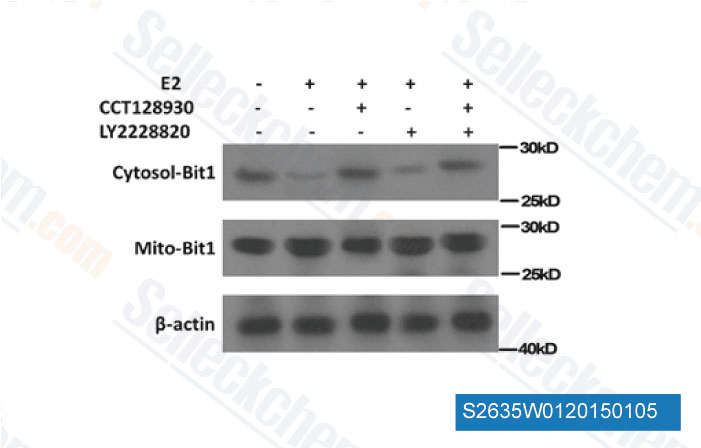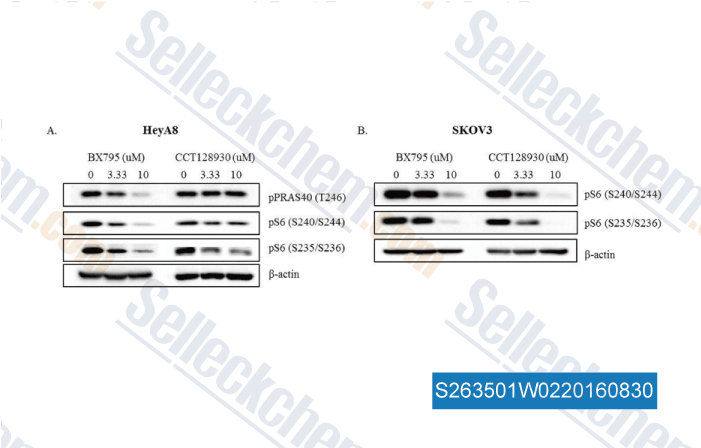|
Toll Free: (877) 796-6397 -- USA and Canada only -- |
Fax: +1-832-582-8590 Orders: +1-832-582-8158 |
Tech Support: +1-832-582-8158 Ext:3 Please provide your Order Number in the email. |
Technical Data
| Formula | C18H20ClN5 |
||||||
| Molecular Weight | 341.84 | CAS No. | 885499-61-6 | ||||
| Solubility (25°C)* | In vitro | DMSO | 25 mg/mL (73.13 mM) | ||||
| Ethanol | 5 mg/mL (14.62 mM) | ||||||
| Water | Insoluble | ||||||
| In vivo (Add solvents to the product individually and in order) |
|
||||||
|
* <1 mg/ml means slightly soluble or insoluble. * Please note that Selleck tests the solubility of all compounds in-house, and the actual solubility may differ slightly from published values. This is normal and is due to slight batch-to-batch variations. * Room temperature shipping (Stability testing shows this product can be shipped without any cooling measures.) |
|||||||
Preparing Stock Solutions
Biological Activity
| Description | CCT128930 is a potent, ATP-competitive and selective inhibitor of Akt2 with IC50 of 6 nM in a cell-free assay, 28-fold greater selectivity for Akt2 than the closely related PKA kinase. CCT128930 induces cell cycle arrest, DNA damage, and autophagy independent of Akt inhibition. High dose of CCT128930 triggers cell apoptosis in HepG2 cells. | ||||||
|---|---|---|---|---|---|---|---|
| Targets |
|
||||||
| In vitro | CCT128930 exhibits marked antiproliferative activity against PTEN-deficient human tumor cell lines including U87MG human glioblastoma cells, LNCaP human prostate cancer cells and PC3 human prostate cancer cells with GI50 of 6.3 μM, 0.35 μM and 1.9 μM, respectively. Furthermore, CCT128930 causes a G1 arrest in PTEN-null U87MG human glioblastoma cells and Akt pathway blockade. [1] | ||||||
| In vivo | CCT128930 at 25 mg/kg i.p. shows a marked antitumor effect in established PTEN-null U87MG human glioblastoma xenografts with a treated:control (T/C) ratio of 48% on day 12. In HER2-positive, PIK3CA-mutant BT474 human breast cancer xenografts, CCT128930 at 40 mg/kg also produces a profound antitumor effect with complete growth arrest and a T/C ratio of 29% on day 22. CCT128930 administrated via i.v. reaches a peak concentration of 6.4 μM in plasma and is eliminated with a relatively short half-life, high volume of distribution, and rapid clearance, giving an area under the curve AUC0-∞ of 4.6 μM h. CCT128930 administrated via i.p. leads to the peak plasma drug concentration of 1.3 μM and the corresponding AUC0-∞ of 1.3 μM·h. Oral CCT128930 administration leads to the peak plasma concentration of only 0.43 μM and a correspondingly low AUC0-∞ of 0.4 μM·h. [1] |
Protocol (from reference)
| Kinase Assay:[1] |
|
|---|---|
| Cell Assay:[1] |
|
| Animal Study:[1] |
|
Customer Product Validation

-
Data from [Data independently produced by DNA Cell Biol, 2014, 33(12), 847-53]

-
, , Cancer Cell Int, 2017, doi: 10.1186/s12935-017-0396-8

-
Data from [Data independently produced by , , PLoS One, 2016, 11(5):e0155053.]
Selleck's CCT128930 has been cited by 33 publications
| The AKT2/SIRT5/TFEB pathway as a potential therapeutic target in non-neovascular AMD [ Nat Commun, 2024, 15(1):6150] | PubMed: 39034314 |
| Structural basis of selective TRPM7 inhibition by the anticancer agent CCT128930 [ Cell Rep, 2024, 43(4):114108] | PubMed: 38615321 |
| Methionine adenosyltransferase2A inhibition restores metabolism to improve regenerative capacity and strength of aged skeletal muscle [ Nat Commun, 2023, 14(1):886] | PubMed: 36797255 |
| PM2.5 induces cardiac malformations via PI3K/akt2/mTORC1 signaling pathway in zebrafish larvae [ Environ Pollut, 2023, 323:121306] | PubMed: 36804889 |
| Functional restoration of lysosomes and mitochondria through modulation of AKT activity ameliorates senescence [ Exp Gerontol, 2023, 173:112091] | PubMed: 36657533 |
| AKT2 reduces IFNβ1 production to modulate antiviral responses and systemic lupus erythematosus [ EMBO J, 2022, 41(6):e108016] | PubMed: 35191555 |
| Increased joint loading induces subchondral bone loss of the temporomandibular joint via the RANTES-CCRs-Akt2 axis [ JCI Insight, 2022, 7(21)e158874] | PubMed: 36173680 |
| Microglia-Neutrophil Interactions Drive Dry AMD-like Pathology in a Mouse Model [ Cells, 2022, 11(22)3535] | PubMed: 36428965 |
| Nanoprotein Interaction Atlas Reveals the Transport Pathway of Gold Nanoparticles across Epithelium and Its Association with Wnt/β-Catenin Signaling [ ACS Nano, 2021, 10.1021/acsnano.1c06452] | PubMed: 34672537 |
| Akt isoforms differentially provide for chemoresistance in prostate cancer [ Cancer Biol Med, 2021, j.issn.2095-3941.2020.0747] | PubMed: 34591413 |
RETURN POLICY
Selleck Chemical’s Unconditional Return Policy ensures a smooth online shopping experience for our customers. If you are in any way unsatisfied with your purchase, you may return any item(s) within 7 days of receiving it. In the event of product quality issues, either protocol related or product related problems, you may return any item(s) within 365 days from the original purchase date. Please follow the instructions below when returning products.
SHIPPING AND STORAGE
Selleck products are transported at room temperature. If you receive the product at room temperature, please rest assured, the Selleck Quality Inspection Department has conducted experiments to verify that the normal temperature placement of one month will not affect the biological activity of powder products. After collecting, please store the product according to the requirements described in the datasheet. Most Selleck products are stable under the recommended conditions.
NOT FOR HUMAN, VETERINARY DIAGNOSTIC OR THERAPEUTIC USE.
